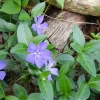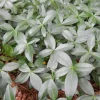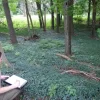X
CONTACT US
Great Lakes Center, SAMC 319
SUNY Buffalo State
1300 Elmwood Ave., Buffalo, NY 14222
wnyprism@buffalostate.edu
(716) 878.4708
SUBSCRIBE TO LISTSERV
FOLLOW US
CONTACT

Common periwinkle flowers are a blue-purple color and arranged in a spiral or pinwheel shape. Photo credit: WNY PRISM
Common Periwinkle
COMMON NAME:
Common periwinkleSCIENTIFIC NAME:
Vinca minorORIGIN:
Asia and EuropeDESCRIPTION:
Common periwinkle is an herbaceous, perennial and evergreen groundcover. The leaves are opposite, elliptic in shape and dark green, though some varieties may have variegated coloration. It produces blue-purple flowers with 5 petals that are blunt at the tip and arranged in a spiral or “pinwheel” shape.HABITAT:
This species prefers rich, moist soil and partial shade, and quickly forms dense mats in forested understories and edges. It often escapes cultivation and moves into adjacent natural areas.THREAT:
Common periwinkle outcompetes native herbaceous species and prevents the establishment of native trees and shrubs. It does not produce food for wildlife as its leaves are toxic, and it rarely produces fruit.MANAGEMENT:
Manual removal should be reserved for small populations as excessive resprouting will occur if any root fragments remain in the soil. Chemical treatment is recommended for larger infestations and can be combined with cutting or mowing. A surfactant may be added to foliar herbicide applications to improve treatment efficacy.
WNY PRISM PRIORITY:
Tier 4 - Local Control
ADDITIONAL RESOURCES:
Native Alternatives
Partridgeberry (Mitchella repens)
Canadian anemone (Anemone canadensis)
Wild ginger (Asarum canadense)
Additional Resources
Indiana Department of Natural Resources Fact Sheet
Pennsylvania Department of Conservation & Natural Resources Fact Sheet
Invasive Species Council of British Columbia Fact Sheet
NYS Prohibited and Regulated Species - Part 575:
PATHWAYS OF INVASION:
This plant is predominantly used as an ornamental groundcover that can easily escape cultivation and form new infestations. It spreads primarily through rhizomes and rarely produces seed, which results in mowing being a primary driver of spread.
REGIONAL DISTRIBUTION:
Common




